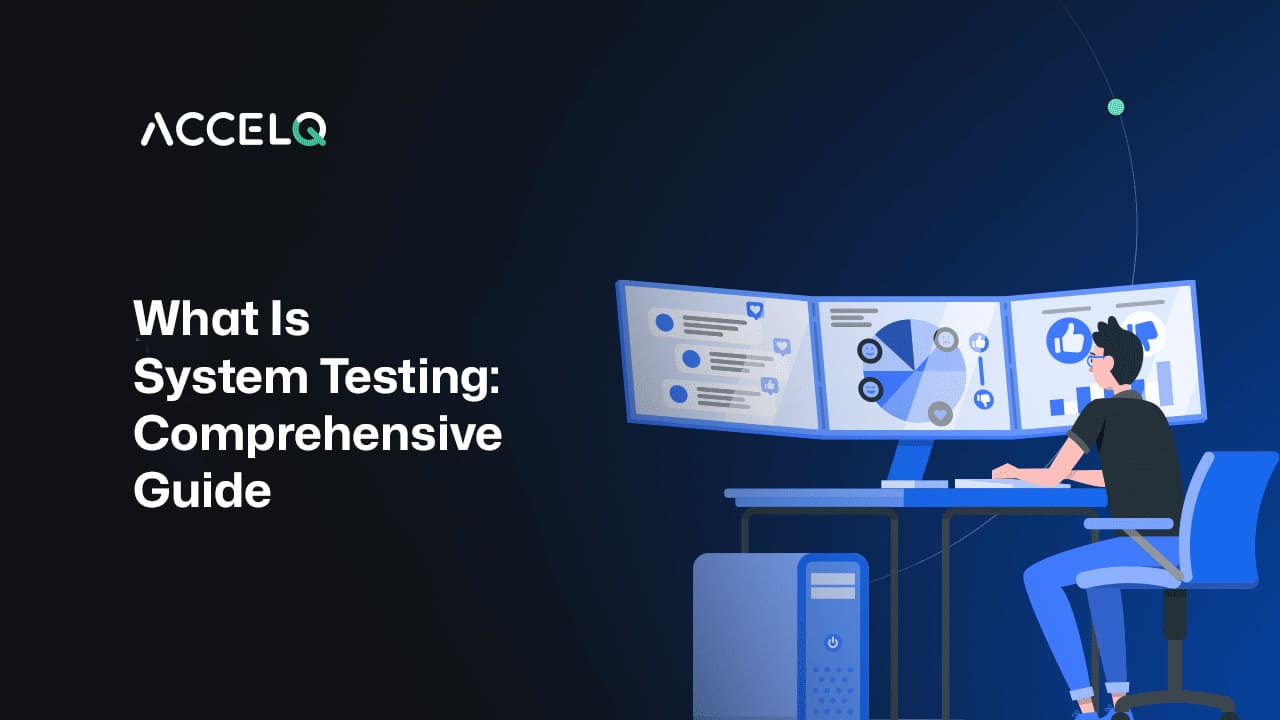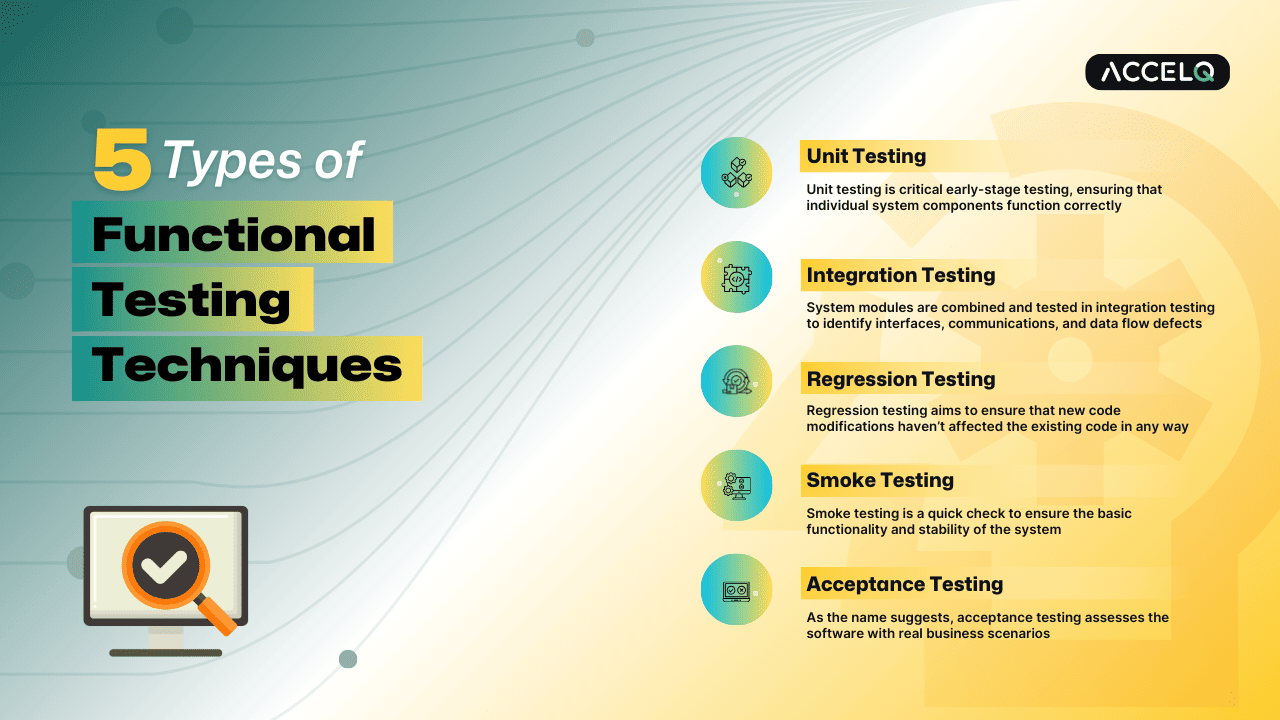Comprehensive Guide to System Testing: Ensuring Software Excellence

System Testing is the essential verification of application performance, functionality, and reliability. This critical step serves as a gatekeeping process, verifying that the software addresses every user need and business goal prior to release. On the other hand, software system testing tests the entire software in a production-like environment, simulating engagements by the end users to uncover issues that could affect the overall user experience, such as UI issues.
System testing offers a complete overview of the software's performance under different conditions, irrespective of whether you are building a web app, mobile app, or an empanada solution. It connects development and delivery, allowing all components to function seamlessly. This guide will cover everything you need to know about types of system testing, including types, examples, best practices, and how ACCELQ can transform your testing process.
What is System Testing?
System testing, commonly known as black-box testing, involves testing the whole system's behavior against expected results. This comes after integration testing but before acceptance testing, focusing on the systems and components that work together.
Key Objectives of System Testing
- Validate the complete integration of all system modules.
- Assess the software’s compliance with business requirements.
- Identify and address defects in the overall functionality and performance.
Types of System Testing: A Comprehensive Overview
System testing in software testing can be divided into two broad categories: functional testing and non-functional testing. Various test types can be performed as part of system testing to ensure the quality of the software.
Functional Testing
| Test Type | Description | Example |
|---|---|---|
| Unit Testing | Verifies the functionality of individual components. | Testing the price calculation module of an eCommerce site. |
| Integration Testing | Ensures seamless interaction between integrated modules. | Checking the interaction between a flight booking system and a payment gateway. |
| Regression Testing | Ensures that new changes don’t disrupt existing functionalities. | Testing login functionality after a website redesign. |
| Smoke Testing | Performs quick checks for system stability. | Verifying an app launches without errors after deployment. |
| Acceptance Testing | Evaluates the system’s readiness for end-user scenarios. | Testing a banking app’s transaction features under real-world conditions. |
Non-Functional Testing
| Test Type | Description | Example |
|---|---|---|
| Performance Testing | Assesses system speed, stability, and responsiveness. | Testing an eCommerce site’s load time during peak traffic. |
| Security Testing | Identifies vulnerabilities and ensures data protection. | Testing login authentication protocols to prevent unauthorized access. |
| Usability Testing | Evaluates the user experience and interface design. | Testing website navigation for ease of use. |
| Compatibility Testing | Ensures smooth performance across different devices and browsers. | Checking an app’s functionality on Android and iOS platforms. |
| Recovery Testing | Verifies the system’s ability to recover from failures. | Simulating a server crash to test data recovery processes. |
How to do System Testing Effectively?
1. Develop a Comprehensive Test Plan
Start by creating a detailed test plan that outlines objectives, scope, and strategies. Include:
- Entry and exit criteria for tests.
- Software requirements and functionality details.
- Timelines for each testing phase.
2. Design Detailed Test Cases
Write clear and actionable test cases to cover various scenarios. Use a structured format that includes:
- Test case ID
- Objective
- Steps to execute
- Expected results
3. Set Up the Testing Environment
Simulate real-world conditions by configuring necessary hardware and software. Ensure consistency to minimize external influences and enhance test accuracy.
4. Execute Testing Protocols
Follow the test plan systematically, recording all errors and suggesting solutions. Use tools to document test results and streamline defect resolution.
5. Analyze and Report Results
Prepare detailed reports highlighting:
- Test coverage
- Defects found and fixed
- Performance metrics
Best Practices for System Testing
- Define Clear Requirements: Establishing precise and measurable objectives ensures a focused testing approach.
- Cover Diverse Scenarios: Include a wide range of input data and conditions to uncover hidden issues.
- Maintain Comprehensive Documentation: Document test cases, results, and defects meticulously for future reference.
- Collaborate Across Teams: Encourage open communication between testers, developers, and other stakeholders to facilitate quick defect resolution.
- Leverage Automation: Incorporate automated tools to streamline repetitive tasks, improve accuracy, and save time.
Real-World Examples of System Testing
| Scenario | Test Type | Objective |
|---|---|---|
| Launching a new eCommerce site | Performance Testing | Ensure fast load times and smooth navigation. |
| Upgrading a banking app | Regression Testing | Verify existing features remain unaffected. |
| Introducing a loyalty program | Integration Testing | Ensure seamless interaction with the payment system. |
The Role of ACCELQ in System Testing
ACCELQ’s AI-powered platform revolutionizes system testing by providing tools for:
- Automated test case generation.
- Seamless integration with CI/CD pipelines.
- Comprehensive test coverage analytics.
ACCELQ empowers teams to realize faster, more dependable, and more economical testing results. ACCELQ can only help you automate your validation process for both enterprise and mobile applications.
Final Thoughts
The system testing phase is required in software development to make sure that your product meets all functional and non-functional requirements, as well as provides a unique user experience. With the right test approach and evolved tools like ACCELQ, you can deliver quality software faster, improve customer satisfaction, and confidently lead the market.
Ready to optimize your system testing strategy? Explore ACCELQ today to unlock unparalleled efficiency and performance in your testing processes.
Geosley Andrades
Director, Product Evangelist at ACCELQ
Geosley is a Test Automation Evangelist and Community builder at ACCELQ. Being passionate about continuous learning, Geosley helps ACCELQ with innovative solutions to transform test automation to be simpler, more reliable, and sustainable for the real world.
Discover More
 Regression Testing: The Ultimate Guide with Examples
Regression Testing: The Ultimate Guide with Examples
Regression Testing: The Ultimate Guide with Examples
 Using Selenium with Python for Automated Testing
Using Selenium with Python for Automated Testing

































